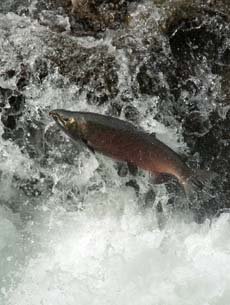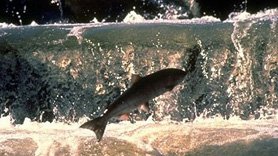Research: Water Chemistry, Internal 'GPS' Are Key to Salmon Homing Instinct
- January 12, 2016
- John Harrison

Behold the remarkable wild salmon.
Born in freshwater, salmon migrate to the vast Pacific Ocean, dwell there for up to five years, then find their way home to the precise place they were born. There, they spawn and die.
How do they do that?
It’s one of the fundamental fisheries research questions, and the answer, as far as it is understood today, has biological as well as policy implications for the future management of these Northwest icons.
It’s a question researchers at the Oregon Hatchery Research Center are pursuing. The Center is a cooperative effort between Oregon State University and the Oregon Department of Fish and Wildlife and is funded by the state. The goal of the Center is to answer questions related to fish recovery and hatchery programs, including the differences between hatchery and wild fish.
Currently, scientists at the Center are looking into several critical issues, including the remarkable homing instinct of the fish.
“Salmon are defined by the fact that they show a homing instinct," Dr. David Noakes, director and senior scientist at the Center, told the Council at a meeting this week in Portland. “They get to do it once, and then they die. They don’t get to learn from experience. If they don’t do it right, all sorts of things get messed up.”
How they do it appears to be twofold: An acute sense of smell, and salmon GPS.
“Juvenile fish imprint on the chemical nature of the water they are raised in before they go to the ocean,” Noakes said. “We raised fish in water from different creeks, and it turns out they do imprint on the water they incubate in. That’s how they come back to a stream, and to a particular part of the stream.”
This has implications for salmon hatchery management. Hatcheries often use well water – it’s cleaner, disease-free, and often colder than stream water. But well water doesn’t have the unique chemical characteristics of stream water. Streams provide habitat for wild fish – the broodstock for hatcheries.
“You could say this is a problem with hatcheries,” Noakes said.
Raising fish in well water leads to straying, he said, because the fish haven’t imprinted on a birth stream. Experiments at the Center point to a possible solution – introducing unique amino acids and chemicals from streams into the well water at hatcheries to help the fish imprint on the places where managers want them to spawn in the wild as adults.

Photo: NOAA Fisheries
But what about their lives in the ocean, where any scent of a unique water chemistry would be undetectable across thousands of miles of open sea?
That’s where salmon GPS comes in. Salmon are born with it, and tests at the Center prove it.
“Geomagnetic orientation. It’s a big idea,” Noakes said. “How do they do it? Do salmon have a GPS? Turns out they do. This is a very important issue for fish management.”
At the Center, scientists have raised fish in tanks surrounded by magnetic fields, which can be manipulated to represent literally any place on Earth. That research shows that from the time they are born, salmon can detect the unique magnetic field of their birth place. Then in the ocean, they sense changes that help them navigate and find their way home.
“They’ve never been anywhere in their lives, but they know how to get there and make corrections along the way,” Noakes said.
Again, there are management implications. The concrete and steel of a hatchery, or the steel hulls of fish barges, can mask the Earth’s magnetic field, at least temporarily, and thus interfere with the homing instinct. Fish raised in a tank that blocks the Earth's magnetic field "are totally messed up,” Noakes said.
Bruce McIntosh, assistant administrator of the Fish Division at ODFW, said the work of the Center does not imply hatcheries are not needed. Far from it. The Center’s research will help improve hatchery practices over time.
“We need both,” McIntosh said. “We can’t have viable hatchery programs without wild fish.”



